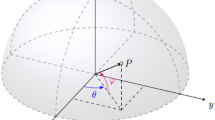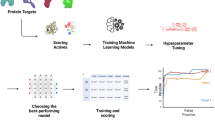Abstract
Rapid overlay of chemical structures (ROCS) is a standard tool for the calculation of 3D shape and chemical (“color”) similarity. ROCS uses unweighted sums to combine many aspects of similarity, yielding parameter-free models for virtual screening. In this report, we decompose the ROCS color force field into color components and color atom overlaps, novel color similarity features that can be weighted in a system-specific manner by machine learning algorithms. In cross-validation experiments, these additional features significantly improve virtual screening performance relative to standard ROCS.


Similar content being viewed by others
References
Ballester PJ, Richards WG (2007) Ultrafast shape recognition to search compound databases for similar molecular shapes. J Comput Chem 28(10):1711–1723
Böhm H-J, Flohr A, Stahl M (2004) Scaffold hopping. Drug Discov Today Technol 1(3):217–224
Chen B, Mueller C, Willett P (2010) Combination rules for group fusion in similarity-based virtual screening. Mol Inform 29(6–7):533–541
Fawcett T (2006) An introduction to ROC analysis. Pattern Recognit Lett 27(8):861–874
Gaulton A, Bellis LJ, Patricia Bento A, Chambers J, Davies M, Hersey A, Light Y, McGlinchey S, Michalovich D, Al-Lazikani B et al (2012) ChEMBL: a large-scale bioactivity database for drug discovery. Nucleic Acids Res 40(D1):D1100–D1107
Grant JA, Gallardo MA, Pickup BT (1996) A fast method of molecular shape comparison: a simple application of a Gaussian description of molecular shape. J Comput Chem 17(14):1653–1666
Grant JA, Pickup BT (1995) A Gaussian description of molecular shape. J Phys Chem 99(11):3503–3510
Hawkins PCD, Skillman AG, Nicholls A (2007) Comparison of shape-matching and docking as virtual screening tools. J Med Chem 50(1):74–82
Hawkins PCD, Skillman AG, Warren GL, Ellingson BA, Stahl MT (2010) Conformer generation with OMEGA: algorithm and validation using high quality structures from the protein databank and cambridge structural database. J Chem Inf Model 50(4):572–584
Horvath D, Marcou G, Varnek A (2013) Do not hesitate to use Tversky–and other hints for successful active analogue searches with feature count descriptors. J Chem Inf Model 53(7):1543–1562
Irwin JJ (2008) Community benchmarks for virtual screening. J Comput Aided Mol Des 22(3–4):193–199
Jain AN, Nicholls A (2008) Recommendations for evaluation of computational methods. J Comput Aided Mol Des 22(3–4):133–139
Muchmore SW, Souers AJ, Akritopoulou-Zanze I (2006) The use of three-dimensional shape and electrostatic similarity searching in the identification of a melanin-concentrating hormone receptor 1 antagonist. Chem Biol Drug Des 67(2):174–176
Mysinger MM, Carchia M, Irwin JJ, Shoichet BK (2012) Directory of useful decoys, enhanced (DUD-E): better ligands and decoys for better benchmarking. J Med Chem 55(14):6582–6594
OEChem Toolkit. http://www.eyesopen.com. OpenEye Scientific Software, Santa Fe, NM
OMEGA 2.5.1.4. http://www.eyesopen.com. OpenEye Scientific Software, Santa Fe, NM
OpenEye Shape Toolkit. http://www.eyesopen.com. OpenEye Scientific Software, Santa Fe, NM
Pedregosa F, Varoquaux G, Gramfort A, Michel V, Thirion B, Grisel O, Blondel M, Prettenhofer P, Weiss R, Dubourg V et al (2011) Scikit-learn: machine learning in Python. J Mach Learn Res 12:2825–2830
Riniker S, Landrum GA (2013) Open-source platform to benchmark fingerprints for ligand-based virtual screening. J Cheminform 5(1):1–17
Riniker S, Fechner N, Landrum GA (2013) Heterogeneous classifier fusion for ligand-based virtual screening: or, how decision making by committee can be a good thing. J Chem Inf Model 53(11):2829–2836
ROCS 3.2.1.4. http://www.eyesopen.com. OpenEye Scientific Software, Santa Fe, NM
Rohrer SG, Baumann K (2009) Maximum unbiased validation (MUV) data sets for virtual screening based on PubChem bioactivity data. J Chem Inf Model 49(2):169–184
Sato T, Yuki H, Takaya D, Sasaki S, Tanaka A, Honma T (2012) Application of support vector machine to three-dimensional shape-based virtual screening using comprehensive three-dimensional molecular shape overlay with known inhibitors. J Chem Inf Model 52(4):1015–1026
Seabold S, Perktold J (2010) Statsmodels: econometric and statistical modeling with Python. In: Proceedings of the 9th Python in science conference, pp 57–61
Svetnik V, Liaw A, Tong C, Culberson JC, Sheridan RP, Feuston BP (2003) Random forest: a classification and regression tool for compound classification and QSAR modeling. J Chem Inf Comput Sci 43(6):1947–1958
Todeschini R, Consonni V (2009) Molecular descriptors for chemoinformatics, volume 41 (2 volume set), vol 41. Wiley, New York
VIDA 4.3.0. http://www.eyesopen.com. OpenEye Scientific Software, Santa Fe, NM
Willett P (2009) Similarity methods in chemoinformatics. Annu Rev Inf Sci Technol 43(1):1–117
Acknowledgments
We thank Paul Hawkins, Brian Cole, Anthony Nicholls, Brooke Husic, and Evan Feinberg for helpful discussion. We also acknowledge use of the Stanford BioX3 cluster supported by NIH S10 Shared Instrumentation Grant 1S10RR02664701. S.K. was supported by a Smith Stanford Graduate Fellowship. We also acknowledge support from NIH 5U19AI109662-02.
Author information
Authors and Affiliations
Corresponding author
Electronic supplementary material
Below is the link to the electronic supplementary material.
Rights and permissions
About this article
Cite this article
Kearnes, S., Pande, V. ROCS-derived features for virtual screening. J Comput Aided Mol Des 30, 609–617 (2016). https://doi.org/10.1007/s10822-016-9959-3
Received:
Accepted:
Published:
Issue Date:
DOI: https://doi.org/10.1007/s10822-016-9959-3




